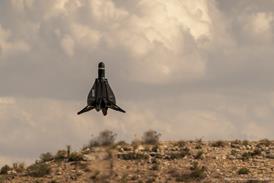Bombardier is targeting a production rate of 20 aircraft per month for its CSeries aircraft by 2016 as the airframer readies to enlarge the Mirabel site dedicated to producing the aircaft.
Gary Scott, president of Bombardier commercial aircraft, says the 65,000m2 (700,000ft2) factory that currently supports production of the CRJ700, CRJ900 and CRJ1000 aircraft will be expanded by just under 92,900m2 to support the CSeries.
The greatly extended Mirabel facility will be able to produce one aircraft every manufacturing day or 20 CSeries aircraft a month by 2016 - three years after the CS100 enters service.
"We're planning, and have all of our suppliers committed to, a day rate," says Scott. "So we will be prepared to go as high as a day rate. Can we go higher? Sure. It'll just take additional investment, but clearly it [the CSeries] is going to need a significant production rate."
Bombardier's ambitious production plans for its new 100- to 125-seat CS100 and 120- to 149-seat CS300 follow similar unprecedented production rate forecasts by Airbus and Boeing to meet customer demand for its next-generation widebodies.
A one-day rate for the CSeries would represent the highest-rate production programme in Bombardier's history. At the height of its production, the CRJ200 reached only a one-and-a-half-day rate or 12-13 a month, and current CRJ production stands at a three-day rate.
Scott says Bombardier plans to build as many as 3000 CSeries aircraft over the next 20 years.
The Mirabel facility will be expanded in phases, the first of which is under way as Bombardier builds the Complete Integrated Aircraft Systems Test Area (CIASTA) for CSeries testing a full year before the first flight of the CS100 in 2012.
The second phase will see construction of supplier support and aircraft integration facilities, says Scott.
Calling the Mirabel expansion a "supersite" is a misnomer, he says, because the globally distributed supply chain will see major portions of the aircraft, such as the wings and centre fuselage, built in Belfast, Ireland and Shenyang, China, respectively.
One such supplier facility will be established by Pratt & Whitney for final engine build-up, enabling delivery of a "fully podded" PW1500G engine along with a Spirit AeroSystems-built pylon from a facility adjacent to Mirabel final assembly, says Scott.
One integration facility will support build-up of the wing box, after it arrives partially integrated from the company's Belfast division. The third phase of the programme will see the construction of the CSeries final assembly line and, later, paint and delivery facilities.
"We have gone all the way from more of a static assembly process," says Scott of Bombardier's current production model. "On many of our current production programmes, we are moving towards a moving line as well, so we embrace the idea of a moving line, but you need to mature your processes and so, initially, CSeries final assembly will be a pulse line, but with the objective of going to a moving line."
The Mirabel growth was first envisioned as a 111,500m2 expansion, but it was later revised downward to less than 93,000m2 by integrating the CSeries infrastructure with the existing regional jet production.
"The expansion is still rather significant," says Scott. "We're going to more than double the Mirabel facility. Essentially, when we first looked at the CSeries, we looked at it more as an adjacent facility to the regional jet facility."
Scott says that as Bombardier "thought through it more", it began to "look for opportunities to integrate it better with the existing regional jet production [at Mirabel]".
Using the existing CRJ administrative facilities as a base to support expansion for CSeries rather than an entirely new administration support building for the new aircraft is "an obvious way to reduce our cost and our footprint", he says.
Source: Air Transport Intelligence news























